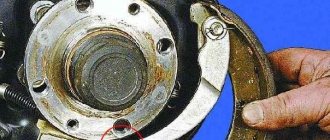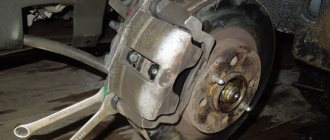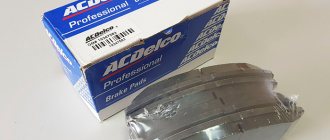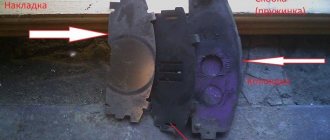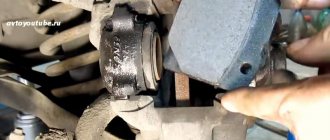The Volkswagen Polo sedan entered the Russian market in 2010, where it truly became the people's car. A distinctive feature of the car is its ease of repair, as well as the availability of inexpensive (both original and analog) spare parts.
One of the most important components of servicing any car is the timely replacement of brake pads. Repairing and servicing the brake system of the Polo sedan is not very difficult, but the owner still needs to know some nuances.
What pads were installed from the factory?
The Volkswagen Polo brake system has several variations. The front wheels on all cars are equipped with disc mechanisms. More advanced configurations have disc brakes on both the front and rear wheels.
In addition, there are differences in standard sizes. Depending on the engine power, larger and more wear-resistant parts were installed. Certain differences in the front brake units can be observed depending on whether the car is equipped with an ABS and ESP system.
But the main thing you have to pay attention to when changing pads is their markings. The presence of one or another marking, depending on the configuration and engine, is most conveniently presented in the following table.
| Engine | Marking |
| 1.4 TSI | 1 ZC |
| 1,6 | 1 ZE 1 ZG |
| 1.6 MPI (90hp) | 1 ZE |
| 1.6 MPI (110hp) | 1 ZC 1 ZE |
Each of the presented types has its own dimensions, in some cases they have almost identical parameters, and the main difference lies in the types of calipers.
For example, pads with the designation 1 ZE have the following dimensions:
- length - 131.2 mm;
- width - 52.5 mm;
- thickness - 17.8 mm.
For blocks with code 1 ZG the following parameters are inherent:
- length -146 mm;
- width - 54.7;
- thickness - 19.6 mm.
The sizes of the 1 ZC pads are represented by the following parameters:
- length -155.2 mm;
- width - 66 mm;
- thickness - 20.3 mm.
All pads manufactured and installed from the factory are designated VAG. This abbreviation classifies spare parts as original. The same replacement pads can be purchased both from an official dealer and from a regular retail chain of auto parts.
It should be noted that original pads are characterized by a somewhat inflated price compared to analogues. For example, 1 ZE pads with article number 6RU698151A can be purchased for an average of 2700-3000 rubles. Marking 1 ZG implies a slightly lower cost, in the range of 2400-2600 rubles (article number - 6R0698151A).
The most expensive original pads will be type 1 ZC pads. Their estimated cost starts from 2900 rubles per set (article number - 5K0698151).
Brake pad selection
The front linings on the Polo sedan, like the rear ones, can only be replaced with a set of four components: two for each disc. Even if one of the brake mechanisms is still fully serviceable, it still needs to be replaced. If you replace only one side, the car may lose stability on the road during braking and skid.
Brake pads are a product that is always in demand among motorists, as a frequently purchased consumable. The market is simply replete with a unique variety of types and brands of mechanisms from various manufacturers. Therefore, in order not to get into a puddle when buying “consumables” and not to purchase counterfeit products, you need to understand exactly which pads are suitable for the car.
For the Volkswagen Polo sedan, it is recommended to buy originals manufactured by the manufacturer. It all depends on the type of configuration.
For the 1ze configuration, front pads with two numbers 6ru698151 or 6ru698151a are on sale. Such devices are usually installed on sedans produced since 2012. The original pads are made in India. Their cost starts from 3300 rubles.
If VAG is too expensive, then you can purchase an analogue from the German company Textar with number 2568101. This is a high-quality sample that can be purchased at a price of 2,200 rubles.
The cheapest replacement option is Korean pads from Sangsin. The cost starts from 1500 rubles.
For the 1zg configuration, originals with code − 6r0698151a are used. As a rule, these linings are used on Polos manufactured before 2012. Branded VAG devices are sold at prices starting from 2,400 rubles. They are made in Italy. There are many analogues. The most popular is a copy from the ATE company for 1,700 rubles.
A note about the type of configuration of the sedan can be found either in the service book in the pr−code column, or in the luggage compartment in the compartment where the spare tire is stored (on a sticker). The third option is to “punch” using the car’s vin number.
DETAILS: What should it be like how to check how to raise
The replacement process is not as complicated as it seems. If you want to save an extra couple of thousand rubles, you can perform the procedure yourself without going to a service workshop.
Before proceeding with the lining replacement procedure, you should check the brake fluid level in the reservoir. If the container is filled to about 0, the liquid should be partially pumped out using a syringe or rubber bulb.
It is forbidden to pump by mouth, as the solution contains toxic substances. If you do not reduce the level of the solution, then when installing new pads it will rise significantly and pour out through the neck.
Fluid leaking from the master cylinder can damage the vehicle's paintwork.
What Russian doesn't like driving fast? After all, even the usual entry of air into the system can lead to deterioration in the performance of the brake pedal and, as a result, an emergency situation. One of the important components of the brake system on the Volkswagen Polo sedan is the front linings.
Like any other component, they tend to wear out. There is no specific replacement interval for pads. If discomfort occurs due to decreased braking efficiency, you should definitely check the thickness of the friction linings.
Deterioration in braking may also be due to loose interaction of the linings with the metal surface of the discs. In addition, when examining the mechanism, you need to pay attention to the pads themselves: whether there are any oil stains, scratches, chips or marks on them.
If you replace only one side, the car may lose stability on the road during braking and skid. The market is simply replete with a unique variety of types and brands of mechanisms from various manufacturers. It all depends on the type of configuration. The original pads are made in India. They are made in Italy.
Interestingly, the originals can be replaced with pads from other Volkswagen models. For example, overlays from a Polo hatchback or even a fourth Golf are quite suitable for old sedans. The replacement process is not as complicated as it seems. If you want to save an extra couple of thousand rubles, you can perform the procedure yourself without going to a service workshop.
Before proceeding with the lining replacement procedure, you should check the brake fluid level in the reservoir. It is forbidden to pump by mouth, as the solution contains toxic substances.
If you do not reduce the level of the solution, then when installing new pads it will rise significantly and pour out through the neck. To replace the linings you will need wrenches with a set of heads, flat and Phillips screwdrivers, jacks, and small wire.
Maintenance and repair. Test your knowledge about the Volkswagen Polo car. We change the front brake pads on a Volkswagen Polo sedan.
Where do you undergo maintenance? At the auto mechanic's garage. Add the site to your bookmarks. It is prohibited to use site materials without the consent of its authors and a backlink.
What non-original pads can be installed?
The market for non-original spare parts is very inflated today. Manufacturers from all over the world are engaged in the production of so-called analogues. Therefore, it will not be at all surprising to find alternative pads on the Volkswagen Polo made in China or Indonesia.
The quality of many of these spare parts, of course, leaves much to be desired, and purchasing them would not be a rational waste of money.
However, there are a number of reliable manufacturers that made a name for themselves many years ago and produce spare parts for a wide range of cars. Spare parts from such a manufacturer in some cases may exceed the cost of the original due to increased performance characteristics.
When producing parts for budget brands, the price of new products may turn out to be much more interesting than that offered by the machine manufacturer.
According to reviews from car enthusiasts who previously installed analog pads on their Polo sedans, it follows that the following manufacturers of brake system elements, in particular pads, have the most optimal price-quality ratio:
- TRW;
- Ate;
- Brembo;
- Ferodo;
- Remsa;
For example, brake pads with code 1 ZE from TRW can be purchased for an average of 1350-1500 rubles (article number GDB2027). 1 ZG pads from Ate (article 13046071112) will cost a little less, around 1200-1300 rubles. Analog brembo coded 1 ZC article P85075 are offered at an average price of 1700-1800 rubles per set.
Catalog numbers (articles)
The question of which pads are best installed on the Volkswagen Polo V sedan can be answered unequivocally - only analogues, namely products from ATE or TRW. Their price per set is 2-3 times less than the original ones, but the resource is the same.
Article numbers of original pads
The originals are indicated in the spare parts catalog with the following codes:
| Caliper type | vendor code | average price |
| 1ZE | 6RU698151B | 2940 |
| 1ZE | JZW698151AK | 2113 |
| 1ZG | 6R0698151A | 2475 |
| 1ZG | JZW698151A | 1945 |
| 1ZC | 5K0698151 | 3043 |
Analogue articles for caliper 1ZE
| Manufacturer | vendor code | average price |
| ABS | 37957 | 2129 |
| ADR | ADR461911 | 595 |
| AMD | AMDBF388 | 705 |
| AVANTECH | AV1901 | 1301 |
| BAPCO | BP0457 | 732 |
| BARNETT | VV002 | 768 |
| BEHR HELLA | 8DB355020521 | 1676 |
| BLITZ | BB0192 | 773 |
| BRANNOR | BRP1776A | 5180 |
| BREMBO | P85121 | 2356 |
| DAFMI | D399E | 660 |
| DEQST | 10BPF00201000 | 678 |
| FRICTIONMASTER | MKD1776 | 1213 |
| FRICTIONMASTER | CMX1776 | 2025 |
| GANZ | GIJ09117 | 1193 |
| HQ | HQ6RU698151A | 683 |
| KONSTEIN | 5611586 | 1478 |
| LYNX | BD8035 | 1242 |
| MARSHALL | M2625681 | 900 |
| MILES | E500042 | 1037 |
| REMSA | 155300 | 1313 |
| SAT | ST6RU698151 | 721 |
| TEXTAR | 2568101 | 2221 |
| VIKA | 66981218501 | 1220 |
Analogue articles for caliper 1ZG
| Manufacturer | vendor code | average price |
| ABS | 37008 | 995 |
| ADR | ADR451211 | 450 |
| ADR | ADR460411 | 506 |
| AKYOTO | AKD1304 | 871 |
| AMD | AMDBF387 | 796 |
| AMIWA | CD01386 | 922 |
| ATE | 13046071112 | 1894 |
| ATE | 13047071112 | 3571 |
| AVANTECH | AV051 | 1252 |
| AYWI | AW1810156 | 898 |
| BAPCO | BP0186 | 857 |
| BEHR HELLA | 8DB355008591 | 1681 |
| BOSCH | 986495004 | 1529 |
| BRANNOR | BRP0768A | 5180 |
| BREMBO | P85041 | 1683 |
| BSG | BSG90200005 | 996 |
| CARLINE | CLN1088 | 979 |
| CIFAM | 8222111 | 2401 |
| COMLINE | CBP0737 | 1314 |
| DAFMI | D137E | 733 |
| DELPHI | LP1436 | 1394 |
| DEQST | 10BPF00014000 | 775 |
| DOUBLE FORCE | DFP1386 | 826 |
| EGT | 321573EGT | 623 |
| FEBI | 16328 | 2146 |
| FERODO | FDB1094 | 1751 |
| FRICTIONMASTER | MKD768 | 740 |
| GBRAKE | GP22004 | 1435 |
| GUD | GBP063300 | 754 |
| GALFER | B1G10203312 | 1190 |
| GANZ | GIJ09036 | 1155 |
| GIRLING | 6119842 | 1687 |
| HDE | 701028 | 665 |
| HELLA PAGID | 8DB355008591 | 1513 |
| H.S.B. | HP5149 | 1609 |
| IBERIS | IB153115 | 1072 |
| ICER | 181338 | 1319 |
| JURID | 571985J | 1678 |
| KAMOKA | JQ1012188 | 1743 |
| KAWE | 63320 | 2407 |
| KOTL | 1357KT | 819 |
| KOTL | 1984KT | 864 |
| KROSS | KV0500103 | 756 |
| KUJIWA | KUF0148 | 795 |
| LGR | LGR6195 | 833 |
| LPR | 5P730 | 878 |
| LYNX | BD8003 | 1032 |
| MARKON | 11000198 | 620 |
| MARSHALL | M2621974 | 909 |
| METELLI | 2202111 | 1377 |
| MEYLE | 252313019A | 1270 |
| MILES | E400054 | 782 |
| MINTEX | MDB2034 | 1704 |
| NIBK | PN0148W | 1788 |
| N.K. | 224740 | 1164 |
| PATRON | PBP1094 | 728 |
| PROFIT | 50001094 | 1130 |
| PROTECHNIC | PRP0223 | 1361 |
| QUATTRO FRENI | QF61000 | 706 |
| REMSA | 63300 | 1347 |
| RIXOS | MD8139WS10 | 1199 |
| ROAD HOUSE | 263320 | 1479 |
| SBS | 1501224740 | 1201 |
| SANGSIN | SP2025 | 1337 |
| SANGSIN | GP2025 | 1771 |
| SFEC | BP011104 | 985 |
| SRLINE | S700020 | 1048 |
| STELLOX | 644020SX | 768 |
| SWAG | 30916328 | 1415 |
| TEXTAR | 2313001 | 1895 |
| TEXTAR | 2313081 | 3906 |
| TOMEX | 1210 | 1309 |
| TRISCAN | 811029019 | 1353 |
| TRUSTING | 2201 | 1162 |
| TRW | GDB1984 | 2077 |
| VALEO | 301332 | 1473 |
| VIKA | 66980008701 | 750 |
| VITE | VBS1357PS | 566 |
| WEEN | 1511124 | 1016 |
| WOKING | P733320 | 1666 |
| ZEKKERT | BS1136 | 907 |
| ZIMMERMANN | 231301951 | 1638 |
Analogue articles for caliper 1ZC
| Manufacturer | vendor code | average price |
| 4U | 4UP03904 | 946 |
| ABE | C1A024ABE | 1427 |
| ABS | 37414 | 1487 |
| ACDELCO | 19374040 | 1521 |
| ADR | ADR451211 | 450 |
| AKYOTO | AKD23105 | 1106 |
| AMD | AMDBF415 | 936 |
| AMIWA | CD1256 | 961 |
| ATE | 13046071842 | 3355 |
| AVANTECH | AV1050 | 957 |
| AYWI | AW1810331 | 1074 |
| BAPCO | BP0280 | 999 |
| BARNETT | SK001 | 1256 |
| BEHR HELLA | 8DB355010581 | 2376 |
| BOSCH | 986424797 | 2383 |
| BRECK | 235870070110 | 1937 |
| BREMBO | P85075 | 2500 |
| CIFAM | 8225480 | 3122 |
| COMLINE | CBP11224 | 1538 |
| DAFMI | D194E | 1294 |
| DELPHI | LP1837 | 2011 |
| DEQST | 10BPF00012000 | 941 |
| DOUBLE FORCE | DFP1550 | 1049 |
| EGT | 321801EGT | 943 |
| FEBI | 16502 | 2009 |
| FENOX | BP43075 | 1130 |
| FERODO | FDB1641 | 2449 |
| FORTECH | FB1233F | 730 |
| FRANCECAR | FCR30B009 | 881 |
| FREMAX | FBP1351 | 1673 |
| FRITEC | SPC8212ZD1107 | 2962 |
| GBRAKE | GP22002 | 1938 |
| GUD | GBP103001 | 977 |
| GALFER | B1G10206802 | 2409 |
| GANZ | GIJ09007 | 1903 |
| GIRLING | 6115502 | 2406 |
| HELLA PAGID | 8DB355010581 | 2222 |
| IBERIS | IB153111 | 1400 |
| ICER | 181567 | 1735 |
| KAMOKA | JQ1013282 | 1878 |
| KEBONO | CD8388W | 1100 |
| KLAXCAR FRANCE | 24994Z | 1140 |
| KONSTEIN | 5610135 | 998 |
| KOTL | 1357KT | 819 |
| KUJIWA | KUF0348 | 913 |
| KUROSAI | KU75013 | 593 |
| LPR | 5P866 | 1409 |
| LYNX | BD1203 | 1173 |
| MAPCO | 6695 | 1564 |
| MARKON | 46522198 | 854 |
| MARSHALL | M2623587 | 1177 |
| MASUMA | MSE0012 | 1878 |
| METELLI | 2205480 | 1908 |
| MEYLE | 252358720W | 1712 |
| MILES | E500131 | 1412 |
| MINTEX | MDB2604 | 1888 |
| NIBK | PN0348W | 2487 |
| N.K. | 224770 | 1488 |
| PATRON | PBP1641 | 1166 |
| PROFIT | 50001641 | 1234 |
| Q FIX | Q0931106 | 1016 |
| QUATTRO FRENI | QF81000 | 830 |
| QUINTON HAZELL | BP1419 | 1379 |
| REMSA | 103001 | 2145 |
| RIXOS | MD8388WS | 1729 |
| ROAD HOUSE | 2103001 | 1992 |
| SANGSIN | SP1692 | 1848 |
| SANGSIN | SP2098 | 2006 |
| SAT | ST5N0698151 | 845 |
| SFEC | BP901837 | 1490 |
| SRLINE | S700069 | 1545 |
| STELLOX | 1041001BSX | 1144 |
| SWAG | 30916502 | 1668 |
| TOMEX | 1311 | 1936 |
| TRISCAN | 811029051 | 1743 |
| TRUCKTEC AUTOMOTIVE | 735137 | 1455 |
| TRUSTING | 5640 | 1836 |
| TRW | GDB1550 | 2706 |
| VAG | 5K0698151 | 4790 |
| VEMO VAICO | V108172 | 3029 |
| VIKA | 66980009201 | 932 |
| VITE | VBS1550PS | 1342 |
| WAGNER | WBP23587A | 1300 |
| WEEN | 1511252 | 1424 |
| WOKING | P1130301 | 1891 |
| ZEKKERT | BS1141 | 1332 |
| ZIMMERMANN | 235872001 | 2857 |
Replacing front pads on a Volkswagen Polo
Replacing the front pads is not a complicated procedure, but it does require special tools and some knowledge.
If there is no urgent need to save the family budget, and if there are official services or regular auto repair shops not far from home, then parts can be replaced there.
If you want to save a few hundred rubles, or you don’t have any desire to go to a service center, then the replacement can be done in your own garage or even on the street.
What tool will you need?
To replace the pads you will need the following tools:
- jack (it is impossible to replace the pads without removing the wheels);
- supports supporting the car (after lifting it on a jack);
- a wheel wrench for unscrewing the nuts or bolts that secure the wheel to the hub;
- a set of socket wrenches for removing brake calipers;
- a screwdriver for pressing out the piston and making it easier to remove old pads;
- pliers may be needed if it is necessary to bend the ends of the fastening brackets;
In addition, instead of a screwdriver, it is advisable to use a special tool to adjust the brake piston. It is a device with which the piston will be pressed into the cylinder, freeing up space for installing new pads.
Tools and materials
With the exception of particularly severe and rare cases, special tools are not required; a standard set for such work is sufficient:
- wheel wrench;
- jack and safety stand;
- wheel chocks;
- a set of motorist tools, including screwdrivers, pliers, hammer, Torx sockets;
- universal penetrating lubricant, for example, the popular WD40;
- copper grease to prevent parts from sticking;
- rags and wire brush.
A special brake drum puller is not required; besides, it is very specific and requires operating skills. You can almost always get by in other ways.
What else will you need to purchase to replace it?
To replace the pads, you may need some brake fluid, since after bleeding the brakes, its level may decrease slightly.
For faster lapping and running-in of new pads, you can use brake lubricant. But the main thing here is not to confuse it and not to apply it to the working surface of the pads. In this case, the effectiveness of the braking system will drop to a critical level, which is fraught with negative consequences.
For immediate replacement, a pair of cloth gloves will not hurt.
Step-by-step process for replacing pads
So, if the brake system fault indicator light comes on on the dashboard, then most likely it’s time to change the pads.
Having purchased the pads themselves, as well as the necessary tools and accessories, you can begin the procedure, which looks like this:
- we lift the car on a jack, and then firmly install it on supports;
- in the engine compartment we find a reservoir with brake fluid, remove the lid from it;
- unscrew the fasteners (bolts) securing the wheel rim to the hub, remove the wheel to the side;
- by selecting a socket wrench, we find the required diameter and unscrew the mount on the caliper, remove the caliper from the brake disc;
- using a screwdriver, press out the brake piston and, if necessary, remove the mounting brackets;
- remove the old pads;
- we lubricate the new spare parts with brake lubricant and install them in technological places, while using a screwdriver or a special device we press the piston so that the pads fit correctly into the required places;
- fix the calipers;
- We fasten the wheel, close the reservoir with a lid, and bleed the brakes.
After replacing the pads, especially if it was your first time, you should check the performance of the brake system at low speed.

